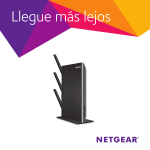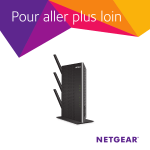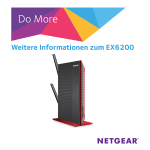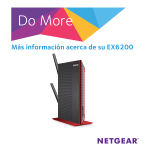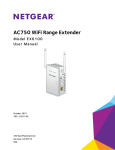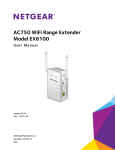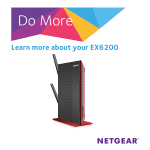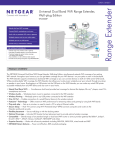Download Netgear EX7000 Owner's Manual
Transcript
Do More Experience Next-Generation WiFi Your new WiFi extender supports the 802.11ac networking standard. This new standard offers better speed, improved reliability, and more range than older WiFi networking standards. Your extender is backward compatible with prior WiFi standards. However, to get the benefits of 802.11ac, your router must support the 802.11ac WiFi networking standard. To learn more about the 802.11ac WiFi networking standard, visit http://www.netgear.com/landing/80211ac/. 2 Use the Extender in Extender Mode Use the extender in extender mode to boost the range of your existing WiFi network. For more information about setting up your extender in extender mode, see the quick start guide card. Router Extender ¾¾ To use the extender in extender mode: 1. Use a WiFi network manager on the computer or WiFi device to find and connect to the NETGEAR_EXT (SSID) WiFi network. After the connection with the computer or WiFi device is established, the Device to Extender LED lights solid green. 2. Launch a web browser. 3. Enter www.mywifiext.net in the address field of the browser. The login screen displays. 3 4. Click the NEW EXTENDER SETUP button. The Extender Setup screen displays. 5. Complete the Extender Setup screen and click the NEXT button. 6. Select the WiFi Range Extender button. The extender searches for WiFi networks in your area and displays a list. 7. Select a WiFi network to extend and click the NEXT button. If you do not want to extend both WiFi bands, clear the 2.4GHz WiFi Networks or the 5GHz WiFi Networks check box. 8. In the Password (network key) field, type the existing WiFi network password and click the NEXT button. 9. Set the network name (SSID) and password for your extender, and click the NEXT button. Your settings are applied. 10. Use a WiFi network manager on the computer or WiFi device to connect to the new extended WiFi network. 11. Click the CONTINUE button. A message displays confirming that the extender successfully connected to the existing WiFi network. 4 Use the Extender in Access Point Mode Use the extender in access point mode to set up the extender as a WiFi access point and create a new WiFi hotspot by using a wired Ethernet connection. Ethernet cable Router Extender ¾¾ To use the extender in access point mode: 1. Use an Ethernet cable to connect your router to the Ethernet port on the extender. 2. Use a WiFi network manager on a computer or WiFi device to find and connect to the NETGEAR_EXT (SSID) WiFi network. After the connection with the computer or WiFi device is established, the Device to Extender LED lights solid green. Note: In access point mode, you can connect your computer or WiFi device to the extender only using a WiFi connection. 5 3. Launch a web browser. 4. Enter www.mywifiext.net in the address field of the browser. A login screen displays. 5. Click the NEW EXTENDER SETUP button. The Extender Setup screen displays. 6. Complete the Extender Setup screen and click the NEXT button. 7. Select the ACCESS POINT button. The extender checks for an Internet connection. 8. Set the network name (SSID), security option, and password for each band, and click the NEXT button. Your settings are applied. 9. Use a WiFi network manager on the computer or WiFi device to connect to the new access point WiFi network. 10. Click the CONTINUE button. A message displays that you successfully created an access point. 6 Log In to Access Extender Settings After installation, you can log in to the extender to view or change the extender’s settings. ¾¾ To log in to the extender: 1. Use a WiFi network manager on a computer or WiFi device to find and connect to the new extended WiFi network. After the connection with the computer or WiFi device is established, the Device to Extender LED lights solid green. 2. Launch a web browser. 3. Enter www.mywifiext.net in the address field of the browser. A login screen displays. 4. Type your email and password and click the LOG IN button. The Status screen displays. 5. Make any needed changes. 7 Share Files Across Your WiFi Network You can share data that is stored on most common USB storage devices across your WiFi network with ReadySHARE® USB Storage Access. ¾¾ To access your USB device from a Windows computer: 1. Insert your USB device into the USB 3.0 port on the extender. If your USB device includes a power supply, you must use it when you connect the USB device to the extender. When you connect the USB device to the extender USB port, it might take up to two minutes before it is ready for sharing. By default, the USB device is available to all computers on your local area network (LAN). 2. Select Start > Run. 3. Enter \\readyshare in the dialog box and click the OK button. A window automatically opens and displays the files and folders on the device. ¾¾ To access your USB device from a Mac: 1. Insert your USB device into the USB 3.0 port on the extender. If your USB device includes a power supply, you must use it when you connect the USB device to the extender. 8 When you connect the USB device to the extender USB port, it might take up to two minutes before it is ready for sharing. By default, the USB device is available to all computers on your local area network (LAN). 2. On a Mac that is connected to the network, launch Finder and select Go > Connect to Server. 3. Enter smb://readyshare in the Server Address field. 4. When prompted, select the Guest radio button. 5. Click the Connect button. A window automatically opens and displays the files and folders on the device. Connect Ethernet-Enabled Devices After the extender is connected to your existing WiFi network, you can connect a wired device to the extender using an Ethernet cable. That device can then access your existing network through the WiFi connection. Extender Router Ethernet cable 9 Blu-ray player Share a USB Printer on the WiFi Network The ReadySHARE Printer utility lets you share a USB printer that is connected to the USB port on your extender. You can share this USB printer among the Windows and Mac computers on your network. ¾¾ To set up ReadySHARE Printer: 1. Connect the USB printer to a USB port on the extender with a USB printer cable. 2. On each computer that will share the printer, do the following: a. Install the current USB printer driver software (available from the printer manufacturer). b. Download ReadySHARE Printer from www.netgear.com/readyshare. c. In the ReadySHARE Printer pane, click the PC Utility or Mac Utility link. d. Follow the onscreen instructions to download the file. 3. Double-click the ReadySHARE Printer utility setup file that you downloaded. The InstallShield wizard displays. 4. Follow the wizard instructions to install NETGEAR USB Control Center. 10 Boost Your Video Streaming Get the most out of your HD entertainment with FastLane technology. FastLane technology connects to your router using one band and connects to your devices using another band. Because a band is dedicated to each function, performance is enhanced. ¾¾ To activate FastLane mode: 1. Use a WiFi network manager on a computer or WiFi device to find and connect to the new extended WiFi network. After the connection with the computer or WiFi device is established, the Device to Extender LED lights solid green. 2. Launch a web browser. 3. Enter www.mywifiext.net in the address field of the browser. A login screen displays. 4. Type your email and password and click the LOG IN button. The Status screen displays. 5. Select Do More > FastLane. The FastLane Technology screen displays. 6. Select the FastLane Technology radio button. 7. Click the Save button. Your changes are saved. 11 Adjust the WiFi Coverage You can set the extender’s WiFi coverage depending on how large you would like your coverage area to be. ¾¾ To adjust the WiFi coverage: 1. Use a WiFi network manager on a computer or WiFi device to find and connect to the new extended WiFi network. After the connection with the computer or WiFi device is established, the Device to Extender LED lights solid green. 2. Launch a web browser. 3. Enter www.mywifiext.net in the address field of the browser. A login screen displays. 4. Type your email and password and click the LOG IN button. The Status screen displays. 5. Select Do More > WiFi Coverage. 6. Select a WiFi Output Power radio button. If your extender is covering a small area, select a lower output power percentage. If your extender is covering a large area, select a higher output power percentage. 7. Click the Save button. Your settings are saved. 12 Optimize Your WiFi The NETGEAR WiFi Analytics app provides detailed information to help you optimize your WiFi home network. To install the app, visit the Google Play store or scan the QR code. The WiFi Analytics app provides the following: • Network status. Get an overview of all available WiFi networks, including signal strength, channel, security protocol, MAC address, and more. • Channel interference. Identify crowded and clear WiFi channels and get channel connection recommendations. • Signal strength. Determine the data rate available in various locations in your home. 13 Frequently Asked Questions You can find more information about your product in the user manual, which is available at http://support.netgear.com. The web browser setup guide keeps asking me for my network password (passphrase) or security key, and I am sure that I entered the correct password. What can I do? The extender is probably placed at the borderline of the range covered by the router or access point. To improve your signal strength, move your extender closer to your router and make sure that the 2.4 GHz or 5 GHz Link Rate LED lights solid amber or green. Solid green. Best connection Solid amber. Good connection Solid red. Poor connection Off. No connection If you are using WEP security, make sure that you are typing the network password in the correct field. 14 I am connected to NETGEAR_EXT and launched a browser. Why can’t I see the web browser setup guide? Try these troubleshooting steps: • Make sure that your computer is set up to use DHCP (most are). • Make sure that the Device to Extender LED is green and that you are using a valid IP address. • Relaunch the web browser and enter www.mywifiext.net in the address field. Type your user name and password and click the LOG IN button. • If you are installing the extender as an access point, make sure that you are connecting your computer or WiFi device to the extender through a WiFi connection instead of an Ethernet connection. How do I restore the extender to its factory default settings? 1. Use a sharp object such as a pen or paper clip to press and hold the Reset button on the bottom of the extender for at least five seconds until the Device to Extender LED blinks amber. 2. Release the Reset button and wait for the extender to reboot. The extender resets and returns to the factory default settings. 15 I forgot my login email and password. What can I do? On the login screen, click the Username & Password Help link to answer the security questions you set up during the initial setup. If you forgot the answers to your security questions, do the following to set up your login credentials again: 1. Restore the extender to its factory default settings. 2. Launch a web browser. 3. Enter www.mywifiext.net in the address field of the browser. The login screen displays. 4. Click the NEW EXTENDER SETUP button. The login setup screen displays. My router security is WEP, and I entered the wrong passphrase or security key on the extender. I cannot access the extender anymore. What can I do? The extender cannot check to see if the WEP passphrase is correct. If you entered the wrong passphrase, your wireless device is not able to get the IP address from the extender. You must reset the extender to its factory default settings to get the IP address back. 16 Can I set up the extender in extender mode if I connect it to the router or access point with an Ethernet cable? No. The extender is designed to connect wirelessly to the router or access point if it is in extender mode. If the extender is in access point mode, you can connect it to the router or access point with an Ethernet connection. For more information about access point mode, see Use the Extender in Access Point Mode on page 5. I enabled a wireless MAC filter, wireless access control, or access control list (ACL) on my router. What should I do when installing the extender? When the WiFi device connects through the extender to your router, the MAC address of the WiFi device shown on the router is translated to another MAC address. If your router’s MAC filter, wireless access control, or ACL is enabled, the WiFi device connects to the extender but cannot get an IP address from the extender and cannot access the Internet. To allow the WiFi device to receive an IP address from the extender and access the Internet, you must provide the translated MAC address to the router. ¾¾ To add a translated MAC address to your router: 1. Log in to your router and disable the MAC filter, wireless access control, or ACL. 17 For more information about how to disable your router’s MAC filter, wireless access control, or ACL, see your router’s documentation. 2. Power on the extender and connect all of your WiFi devices to the extender. 3. Make sure that the Link Rate LED remains lit. 4. Log in to your extender: a. Launch a web browser. b. Enter www.mywifiext.net in the address field of the browser. A login screen displays. c. Type your email and password and click the LOG IN button. 5. Select Settings > WiFi Settings. 6. Scroll down and select Connected Devices. The Connected Devices section displays the MAC addresses and virtual MAC addresses for computers and WiFi devices that are connected to the extender network. 7. On the router, add all of the virtual MAC addresses from your extender to your router’s MAC filter table. 8. Pull out the product label from the extender and find the extender’s MAC 1 and MAC 2 addresses. 9. Add the extender’s MAC 1 address to your router’s MAC filter table. 10. Add the extender’s MAC 2 address to your router’s MAC filter table. 18 You must type 02:0F:B5: first, then type the last six digits of your MAC 2 address after. For example, if your MAC 2 address is C4:04:15:5F:20:AC, type 02:0F:B5:5F:20:AC in your router’s MAC filter table. 11. Convert the extender’s MAC 1 address and add the new MAC 1 address to your router’s MAC filter table. For more information, see the extender’s user manual. 12. Convert the first two hexadecimal values in the extender’s MAC 1 address to binary. See the extender’s user manual for the conversion table. 13. Toggle the second-to-last digit of the binary code to 1 or 0. If the second-to-last digit is 1, toggle it to 0. If the second to last digit is 0, toggle it to 1. 14. Convert the new binary code back to a hexadecimal value. See the extender’s user manual for the conversion table. 15. Replace the first two hexadecimal values in the old MAC 1 address with the new value you converted and add the new MAC 1 address to your router’s MAC filter table. For example, if your old MAC 1 address was C4:04:15:5F:20:AD, your new MAC 1 address is C6:04:15:5F:20:AD. 16. Enable the router’s MAC filter, wireless access control, or ACL. 19 Support Thank you for purchasing this NETGEAR product. After installing your device, locate the serial number on the label of your product and use it to register your product at https://my.netgear.com. You must register your product before you can use NETGEAR telephone support. NETGEAR recommends registering your product through the NETGEAR website. For product updates and web support, visit http://support.netgear.com. NETGEAR recommends that you use only the official NETGEAR support resources. You can get the user manual online at http://downloadcenter.netgear.com or through a link in the product’s user interface. Trademarks NETGEAR, the NETGEAR logo, and Connect with Innovation are trademarks and/or registered trademarks of NETGEAR, Inc. and/or its subsidiaries in the United States and/ or other countries. Information is subject to change without notice. © NETGEAR, Inc. All rights reserved. Compliance For the current EU Declaration of Conformity, visit http://support.netgear.com/app/answers/detail/a_id/11621/. For regulatory compliance information, visit http://www.netgear.com/about/regulatory/. See the regulatory compliance document before connecting the power supply. NETGEAR, Inc. September 2014 350 East Plumeria Drive San Jose, CA 95134, USA




















